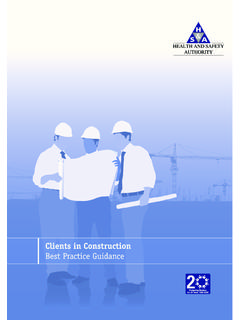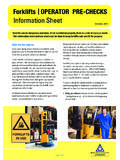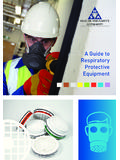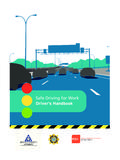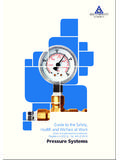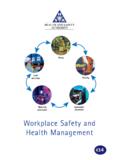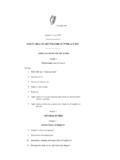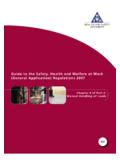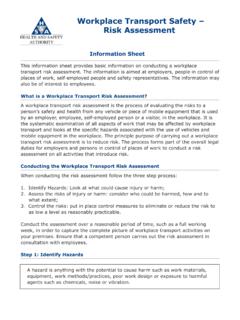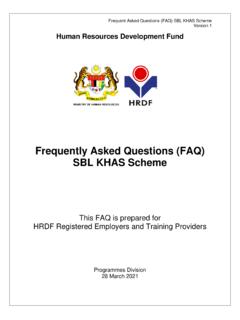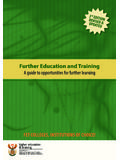Transcription of SAFETY WITH LEAD AT WORK - Health and Safety Authority
1 A guide for employers and employeesSAFETY WITH LEAD AT WORKOur vision: A country where workersafety, Health and welfareand the safe managementof chemicals are central tosuccessful enterpriseINTRODUCTION ..2 WHAT IS LEAD? ..2 POTENTIAL Health EFFECTS FROM EXPOSURE TO LEAD ..2 COMMON WORK SITUATIONS CAUSING LEAD EXPOSURE ..3 WHAT PROTECTIVE MEASURES SHOULD GENERALLY BE TAKEN WHEN WORKING WITH LEAD? ..4 WHAT PERSONAL PROTECTIVE EQUIPMENT (PPE) SHOULD BE USED WHEN WORKING WITH LEAD? ..5 WHAT IS THE ROLE OF Health SURVEILLANCE? ..5 MEASURING WORKER EXPOSURE TO LEAD ..6 KEY POINTS FOR EMPLOYERS ..7 KEY POINTS FOR EMPLOYEES.
2 7 WHAT LEGISLATION IS APPLICABLE TO WORK WITH LEAD? ..7 FURTHER INFORMATION ..8 OTHER USEFUL SOURCES OF INFORMATION ON LEAD ..8 APPENDIX 1 ..9 APPENDIX 2 ..10 Published in February 2014 by the Health and SAFETY Authority , The Metropolitan Building, James Joyce Street, Dublin 1. SAFETY with Lead at Work GuideSafety with Lead at Work GuideContentsWhat is lead? Lead is a toxic heavy metal and it is found in manydifferent products including rolled lead sheeting,paints, glass, solder, plastic and rubber compounds,therefore, workers can be exposed to lead in a varietyof work detailed information is included in Appendix 2relating to the use and risk of lead exposure Health effects from exposure to leadLead exposure is one of the oldest known occupationalhazards.
3 The two routes of entry for lead in to the bodyare: inhalation of dusts or fumes containing lead andthe ingestion (swallowing) of lead containing is very toxic to the human body and prolonged orrepeated exposure causes damage to the nervoussystem, kidneys, blood and it is suspected of causingcancer. Page 2 This guideprovides generalinformation onlead with regardto chemicalhealth and safetyissues forworkers using orexposed to leadwhile they are atwork. As lead is used inmany different worksituations it is not possible to cover all scenarios in detail. Additional sources of information on lead are available and are listed in this publication has been prepared to provide basic guidance and is not intended as a legal interpretation of the legislation referred to herein.
4 SAFETY with Lead at Work GuideIntroductionHigh levels of exposure over a short period of timecan cause acute poisoning and symptoms of acutepoisoning include a metallic taste in the mouth andvomiting, abdominal cramps, constipation anddiarrhoea. Long term exposure to lower doses causes chronicpoisoning but symptoms of chronic poisoning aremore difficult to spot as they are very similar to manyother common complaints. Characteristic symptomsof chronic poisoning include a blue line in the gumsand a drop wrist . Severe abdominal pain and pallormay also be people are more susceptible thanadults as they absorb greater amounts from thegastrointestinal tract.
5 Lead is acumulative toxin with 90%found in the bones. Lead isparticularly toxic to childrenas lead exposure in childreninterferes with thedevelopment of the nervoussystem causing potentiallypermanent learning andbehavioral people maysuffer skeletal changesfollowing chronic exposure. Women of reproductive age are at a higher risk ofdamage from lead exposure because it can affectfertility, and increase the risk of stillbirths andmiscarriages. As lead is a mutagen, it can also causegenetic defects. A pregnant employee must informher employer at the earliest opportunity of herpregnancy to enable an adequate risk assessment tobe , if a worker brings lead contamination home, forexample, on their work clothing, his or her partnerand children are at a higher risk of Health effects dueto lead exposure.
6 Common work situations causing leadexposure with solid lead sheet When handling a clean solid lead sheet, the potentialrisk of exposure to lead is not considered to besignificant. Significant lead exposure could occur ifthe work involves the stripping off of old existingsheets from a roof where the underside is dust could be released and then respiratory protection should be worn andgood occupational hygiene practiced. The melting down of lead for thecaulking of sheet joints shouldbe carried out at lowtemperatures below 500 C toprevent lead fumes beingformed, which if inhaled maycause significant lead exposureto workers.
7 Further detailedinformation on industry bestpractice for this type of workcan be obtained from the UKLead Sheet Association( ) lead welding is carried out in a confined space withinadequate ventilation for lengthy periods of time, therisk of lead exposure could be significant. Mostconstruction work on site is carried out for shortperiods of time in open air so the risk of lead exposureis normally with Lead at Work GuidePage 3 SAFETY with Lead at Work involving renovation, repair andpainting (RRP)Lead-based paintswere widely available and , most old houses or buildings will containsome lead-based paint. In poorly maintained buildingsthe lead paint flakes and peels off and can then beinhaled.
8 Uncontrolled or uncontained dust and debrisfrom renovation works or repainting can expose theworkers doing the work and occupants of the buildingto unsafe levels of abatement projectsaredesigned to permanently eliminateexisting lead based hazards andprevent future lead exposure. But thiswork often involves high risk of workerexposure to lead unless the work iswell planned and the workersprotected with adequate respiratoryprotective equipment. An example ofthis would be the removal of lead-based paint from starting this type of work, alead risk assessmentshould becompleted. Lead risk assessments aredesigned to identify the lead hazardsand management strategies.
9 Leadsurveys are designed to locate all lead-based paint in the building. Lead surveys must alwaysbe carried out by a person who is competent to do thework. They should have adequate knowledge,training and expertise in understanding hazards andassociated risks. They should know the work activitiesthat uses and produces lead. Workers must be trained and be competent toconduct lead-based paint activities. Workers mustensure that work areas are sealed off to prevent leaddust spreading and contaminating other workers orthe building itself. Workers not directly involved withlead work, for example, scaffolders, can be exposedto lead from inhalation and ingestion of lead fromcontaminated Recovery and recycling of scrap and wasteThe UK Lead Sheet Association( ) have provided information forindustry good practice for the recovery of old leadsheeting and off cut retrieval in the form of a simplecode of practice to follow for construction andbuilding protective measures should generallybe taken when working with lead?
10 It is critical to avoid the inhalation of lead dust, fume orvapour or swallowing lead when a person eats, drinks,smokes or bite their nails without washing their handsor face first. Some general advice is provided below. Employees must be given lead SAFETY information and trainingby their employer. All risks to lead workers must be considered in a written risk assessmentbefore work starts. It must include arrangements to deal with accidents, Page 4 SAFETY with Lead at Work Guideincidents and emergencies such as an uncontrolled release of lead dust or fume etc. Avoid allowing lead dust becoming airborne for example by using tools with suitable extraction.
